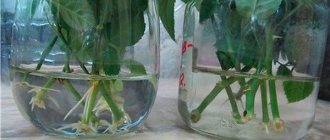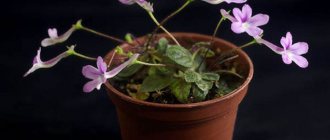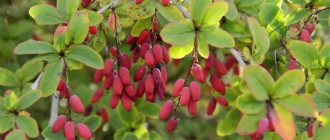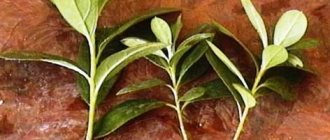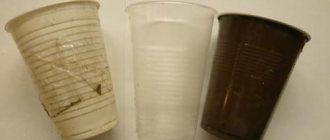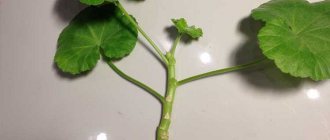Geranium, or pelargonium, is very popular among gardeners for its unpretentious nature and wide palette of colors. Bright and varied inflorescences serve as decoration for the garden and add color to any interior, be it an office or a living room. The plant is easy to care for and easily reproduces vegetatively and with the help of seeds.
Geranium, or pelargonium, is very popular among gardeners for its unpretentious nature and wide palette of colors. The illustration for the article is used under the standard license ©dachnyedela.ru
Cuttings
There are two methods of cuttings:
- You need to select side shoots 5-7 cm long with 2-3 leaves. Cut the shoot from the parent stem with a sharp knife. The resulting cuttings should lie down for 2-3 hours so that the cut area dries out. After this, treat the cut area with activated carbon.
- Two weeks before the cutting procedure, make circular cuts through the bud on the bare trunk of the parent plant. At the site of the cut, gum appears, in which the rudiments of roots are formed. Carefully separate the cuttings from the mother stem.
This method of cutting is considered radical, but more effective. The shoots quickly take root and grow.
Flower growers prefer the vegetative method of propagating pelargonium. The illustration for the article is used under the standard license ©dachnyedela.ru
Rooting a geranium leaf in water
Propagation of geranium by leaves will only give results if you carefully select planting material. It is necessary to take into account that there are no nodes on the leaf plate of pelargonium that could form roots. Therefore, it is necessary to select a healthy leaf with a dense petiole and cut it along with part of the stem at an acute angle.
For rooting, the leaf is placed in a small transparent container with settled water. It is advisable to dissolve activated carbon (500 mg) in it, which will protect the stem from rotting. The water should be changed once a week without allowing it to become cloudy.
Pelargonium leaves for rooting
How to root shoots correctly
In order for the plant to take root and take root, it is necessary to prepare the right soil. Its composition should include soil with ⅓ agrovermiculite and sand. The bottom of the container where the cuttings will be planted is lined with expanded clay or polystyrene foam, and the prepared soil is poured on top. Before planting, the soil must be disinfected.
- Shoots with root rudiments are planted in the soil to a depth of 2-3 cm.
- Leave in a cool place, without direct access to sunlight.
- Water the cuttings carefully, moderately, through a tray. Avoid excessive moisture.
- If the leaves begin to turn yellow, cover the plant with a glass jar.
- A full-fledged root system develops within a few days.
For rapid root growth, you can use water:
- Cut shoots treated with charcoal are placed in a jar of water.
- To speed up the process, you can add activated carbon to the water.
- The roots are expelled very quickly. Within 2 weeks, a full-fledged root system is formed.
Whimsical varieties - breeding features
The most capricious varieties of the Geranium family are considered royal (grandiflora) and ampelous (or ivy-leaved).
Having acquired a beautiful grandiflora, a gardener often asks the question: how to propagate royal geranium at home, are there any differences from simple plant species? Basically, the finicky variety is propagated in the same way as regular geranium. But there are several features:
- The main one is that you don’t even have to try to put its sprouts in water to get roots. It is unlikely that this rooting practice will be effective; most likely, they will all rot and disappear.
- The soil mixture for them is prepared from peat and leaf humus.
- The plant will take a long pause before it begins to bloom. The period from planting to first flowering takes about a year.
Dividing the bush
Pelargonium must be replanted every 3 years. If this is not done, the plant grows greatly, the stems become denser, the inflorescences become smaller and lose their attractiveness.
This method is quite traumatic for geraniums, and if the division is done incorrectly, the flower may die.
- Carefully remove the geranium from the flowerpot. Remove excess soil and inspect the roots.
- The roots are divided into ground buds. They must be healthy, without signs of rot or wilting.
- The division with buds is carefully separated from the main plant and transplanted to a new location.
- Geranium does not like excessive watering, especially in the first days after transplantation.
In order for the plant to take root and take root, it is necessary to prepare the right soil. The illustration for the article is used under the standard license ©dachnyedela.ru
Ivy geranium - propagation
It is best to propagate ampelous geranium at home by cuttings using the information above. If the gardener decides to propagate ampelous geraniums by cuttings, then after the seedlings take root and are ready to be transplanted to a permanent place, it is important to choose the right container for them.
It will be better for a young plant to bloom if it is planted in a small enough pot, not much larger than the size of the root system. Only in this case will the plant be strewn with lush caps of inflorescences, descending down with beautiful vines. In addition, ivy-leaved geranium can be propagated by seeds. You can read about ivy-leaved pelargonium here.
The best time to propagate geraniums
Geraniums should be propagated in the spring. It is at this time of year that all vital processes in the plant are activated, they are significantly accelerated in their work, and this, in turn, contributes to rapid adaptation and growth.
Of course, it is not forbidden to propagate geraniums at other later times, but then flowering will be significantly delayed. You won't see it until next year.
Seedling care
Reproduction of pelargonium will be successful if the temperature is maintained from +18 to +24 ° C and protected from drafts. Particular attention should be paid to maintaining soil moisture. The plant does not need to be watered for the first 8-10 days after planting. Subsequently, watering is done with soft water at room temperature once every 3-4 days, trying to avoid excess moisture. For geraniums, a large amount of water is more destructive than a lack of it.
Pelargonium needs regular feeding with mineral fertilizers. 2 weeks after planting the leaves in the ground, you can begin to feed them with universal store-bought products containing potassium, phosphorus and iodine. Fertilizers are applied after watering using a spoon at the root of the plant.
Rooting pelargonium cuttings in peat tablets. Propagation of geraniums by cuttings
Through trial and error, I came to the conclusion that the best soil for rooting is a special soilless mixture (peat tablets), which can be purchased at flower shops.
- The mixture is absolutely sterile, there are no additives in it, so the cuttings take root in it perfectly.
- There are no bacteria in the soilless mixture, which means that the cuttings will not rot, which happens quite often when using garden soil.
For containers, I choose ordinary disposable cups of different colors: transparent, white or dark. I root pink, white or red geraniums in them, respectively, so that when planted in pots I get uniform compositions. If you need to root geraniums of the same color, it is more convenient to use transparent cups - the roots are clearly visible in them. First, I make drainage holes in the cups with a knife.
Photo: containers for geranium cuttings
- A week before cuttings, I water the geranium with any fertilizer for indoor flowers to enhance the growing season.
- I use a dose 2 times less than indicated in the instructions.
- Before watering with this fertilizer, I water the soil with a small amount of water so as not to burn the roots.
Pruning geranium cuttings
- I arm myself with sharp scissors and cut off the tops of the shoots with the first two internodes. Such cuttings are usually 15 - 20 cm long.
- Side shoots of the same length are also suitable for cutting.
- If, after cutting the top of the stem, there are shoot buds in the internodes, then I also take this part of the stem to the cutting.
Photo: geranium cuttings from the top of the stem In the case when new shoots between the stem and the leaf are not visible on the remaining stems, I do not use them to obtain cuttings, I leave them in this form.
Such geraniums with tall, almost bare stems look very unsightly, but literally after 2 weeks shoots will appear from the internodes, and the remaining stems can be cut into cuttings again.
Photo: geranium cuttings from the top and middle of the stem Even if so many cuttings are not needed, I am in no hurry to shorten the remaining stems after the first cutting. I finally cut the stems at a level of 10 cm above the soil only when the first batch of cuttings have taken root, so that in case of unsuccessful cuttings there is spare material. After the second cutting of the cuttings, the queen cells produce new shoots and bloom luxuriantly by mid-May. In May, I replant the plants, replace the soil with well-rotted compost, after which flowering continues until the end of autumn. I save the queen cells for 3 - 5 years, after which I replace them.
How to prune geraniums
- From cut cuttings, I remove all leaves except one top or side one.
- If the leaf blade is large, I cut half of it.
- The remaining leaf should be short and smaller in size compared to the rest.
- If a new leaf is just starting to open from the top of the shoot, I leave that one and cut off the rest.
- All buds and flowers must also be cut off.
- There is no need to leave more than one leaf, otherwise the geranium cuttings will not have enough strength to feed it and form roots at the same time.
- Using a sharp knife, I cut the bottom of the cutting diagonally and leave the cuttings for a couple of hours so that the cuts dry.
How to propagate geranium leaves at home
How to propagate Decembrist at home: examples without roots and leaves
In some cases, it happens that a healthy, strong cutting cannot be propagated. In such cases, a plant leaf is used. The leaf itself will not be able to take root; you can help it. To do this, leave part of the stem along with the leaf. After cutting the stem and leaf, the treatment is carried out as for cuttings. Soil preparation follows the same principle as with conventional cuttings. Next, a transparent cup is filled with the substrate, into which you need to plant a stump with a leaf. The scheme for caring for such seedlings is identical to that for caring for cuttings.
Reproduction by leaf
How to propagate royal geranium from cuttings at home
How to propagate ampelous geranium at home
One of the most beautiful types of geranium is the royal pelargonium. Breeders have developed a large number of varieties of royal and ivy pelargonium, but all of them are more demanding in care and propagation compared to other species. To know how to propagate royal geraniums by cuttings at home, you need to follow the step-by-step diagram used by experienced gardeners.
What does a geranium cutting look like?
It is important to know! The main requirement when propagating royal pelargonium is to avoid excess soil or substrate moisture. If there is excess moisture, the shoots of the plant will begin to rot and disappear.
How to take geranium cuttings from the mother plant
To obtain new royal geranium plants, it is better to propagate by cuttings from late August to early September. Since pruning occurs after flowering, the cuttings for propagation will be strong and healthy.
In spring, the plant wakes up from hibernation. All vital processes begin to activate, and if you choose the right time, you can enjoy lush flowering as early as June. The opposite result may also occur, and then flowering will occur only after a year. How does geranium propagate?
Geraniums should be propagated from a healthy and strong-looking mother plant. The average cutting length is 8-20 cm, depending on the size of the original flower. Shoots with more than 5-6 leaves are not recommended to be taken due to the low probability that the cutting will give off roots.
Additional Information! The cuttings are separated from the mother shoot using a sharp knife below the node at a slight angle. After this, the lower leaves on the cuttings are removed. If the cutting has too large upper leaves, then they must be cut in half so that all the forces of the future plant are not spent on feeding the leaves, but go towards the formation of the root system.
Rooting methods
There are several ways to root geranium from cuttings obtained:
- using plain water;
- planting in light soil;
- use a specialized peat tablet.
Each method has its own characteristics, and the success of any method depends on the technology for obtaining the mother bush. When choosing a similar scheme, the chances of a positive result increase, and rooting occurs faster.
Obtaining roots using plain water means replacing the liquid every 2-3 days. An opaque container is filled with water no more than 3-5 cm and placed on a well-lit window. After the roots appear, the cuttings are planted in temporary pots with rich soil.
Using the method of planting in light soil, the planting material is pre-dried for about 2 hours, the cut areas are treated with charcoal and planted in the ground without waiting for roots to appear.
On a note! A pot for rooting is chosen with a small diameter, the lower part is filled with drainage, the rest of the container is filled with a substrate of peat and sand in equal volumes.
The best method of vegetative propagation of royal pelargonium is rooting using a peat tablet. This method does not involve planting shoots in the ground, but is based on the use of a special medium of peat and nutrients. This substrate promotes rapid growth of plant roots. The likelihood of stem rotting is minimized, but before placing the shoot in a peat tablet, it is kept in water for 5-15 days until the first roots appear. When the roots completely entwine the tablet, immediately begin planting them in a spacious pot.
Peat tablets for rooting geranium cuttings
Planting in the ground and further care
Cuttings of royal geraniums are popular due to the rapid rooting provided that all the rules of this procedure are followed. After the formation of the root system, the first sprouts begin to appear on the cuttings within 3-4 weeks, at which time watering is increased.
Note! Water the plant carefully; do not overdo it with moisture. Royal geranium tolerates drought better than excess moisture.
Increasing watering does not mean that the flower is ready for full care like an adult plant. You need to wait another month before you begin to gradually harden the flower in the sun. After a while, the plant is transferred to a care regimen like an adult.
Transplantation into permanent soil is carried out only after the formation of a strong root system. If you replant earlier, there is a chance that the plants will not take root. The soil is prepared from compost (humus, sand, leaf and turf soil in equal proportions).
During the cold season, the flower is dormant. Growing in winter takes place at a temperature of +15 ℃. If it is impossible to create such conditions, the plant is left dormant until March. The shoots are shortened, the roots are cleared of soil and trimmed, wrapped in newspaper or film and then hung in the basement.
Planting cuttings in the ground
Ready geranium cuttings
Pelargoniums are quite easily propagated by cuttings; with the right approach, the survival rate of cuttings is 80-90%. Gardeners consider the best time for cuttings to be the beginning of March, before the period of active growth and flowering, or September, the time before the onset of the dormant period. If necessary, geranium can be propagated in winter, but the survival rate of cuttings may be less than in spring or autumn. Let's consider the features of cuttings for each season.
Cuttings in spring
It is believed that during this period of time cuttings have the greatest ability to take root and quickly take root. All this is due to the fact that their harvesting and germination is carried out before the start of the period of active growth and development of the plant.
Planting cuttings in separate brackets
For cuttings, select healthy plants that need pruning after winter. Pruning in the spring will benefit the plant itself, as it promotes not only the formation of young shoots, but also the formation of flower stalks.
From the branches remaining after pruning, the strongest shoots are selected, shortened to a length of 12-15 cm, and no more than 3-4 leaves are left at the top. Cuts of shoots are treated with crushed charcoal or activated carbon.
Planting cuttings in the mother liquor
The prepared cuttings are left to dry for 3-4 hours at room temperature, and they are ready for planting in the mother liquor. Plants obtained from cuttings at this time can bloom by early summer.
Queen cell arrangement
For a queen cell for germinating cuttings, a large but shallow pot or just a wooden or plastic box is suitable. The main requirement is that the box has good drainage and drainage holes.
- A layer of drainage should be poured into the selected container, and then filled with soil.
- The soil for germination should be either universal, or you can prepare it yourself. To prepare it yourself, take one part each of sand and charcoal, 2 parts each of leaf and turf soil, 2 parts leaf humus and peat, and mix everything well.
- The substrate should be light and loose.
- Before planting the cuttings, the substrate is well moistened and excess moisture is allowed to drain.
If it is not possible to add charcoal, you should treat the soil with any systemic fungicide or just a weak solution of potassium permanganate, this will help avoid rotting of the base of the cutting.
Planting cuttings in the mother liquor
After the excess moisture has drained from the glass, pelargonium cuttings can be planted in the mother liquor. They are placed in even rows at a distance of 3 cm from each other, the distance between the rows should also be at least 3 cm. After planting, the cuttings should not be watered, just lightly press the soil at the base of the cutting.
Plant care
The cuttings do not require any special care. Watering is carried out as the top layer of soil dries. If the room where the mother plant is located has very dry air, then the plants can be sprayed from time to time. Cuttings germinate well at temperatures from 18 to 24⁰C. At lower or higher temperatures, the survival rate of cuttings may be reduced.
Pelargonium cuttings do not need greenhouse conditions, or rather, placing the mother plant in a greenhouse is even contraindicated for them, since too high air humidity leads to plant rotting or the formation of fungal diseases.
The cuttings take root in about a month. A sign of rooting is the appearance of new young leaves at the top of the cuttings. A month after rooting, the plants can be planted in separate pots.
Propagation of pelargonium by cuttings
Flower growers recommend doing the cutting procedure in the spring (from February to April) or at the end of summer. Cuttings can also be obtained from a flowering plant during the active growing season, but such seedlings take root less well. There are several recommendations on how to cut geraniums:
- The shoots are cut 7-10 cm long, the cut is made oblique.
- Cuttings are selected whose planting ends are slightly lignified. In this case, roots form more easily.
- For propagation, apical or lateral shoots are used.
- Each cutting should have at least 2-3 growth points for future leaves.
The degree of rooting of cuttings depends on compliance with the rules outlined below. On average, 85-90% of their total take root. Some gardeners believe that royal geraniums take root better when cut in the fall.
Care instructions
Pelargoniums belong to the genus of herbs, which unite about 250 species, distinguished by a variety of shapes and colors of leaves and flowers. In indoor floriculture, mainly 3 types are grown - zonal, royal and ivy-leaved (ampeloid varieties) pelargonium. They are quite unpretentious and durable. In mild climates, the plant can spend the winter in open ground.
When grown in the garden, geraniums are brought into a cool, dry room for the winter, removed along with a lump of earth. The plants are placed in a wooden box close to each other, and the shoots are cut off in March-April. How to propagate pelargonium is described below.
Adult plants need a lot of light, they tolerate direct sunlight well and love dry, well-lit places. At high humidity, pelargonium can get damaged, even if the temperature is above zero. It is easily susceptible to fungal diseases, so the soil should not be over-moistened. To maintain abundant flowering, you need to regularly remove dry leaves and inflorescences.



